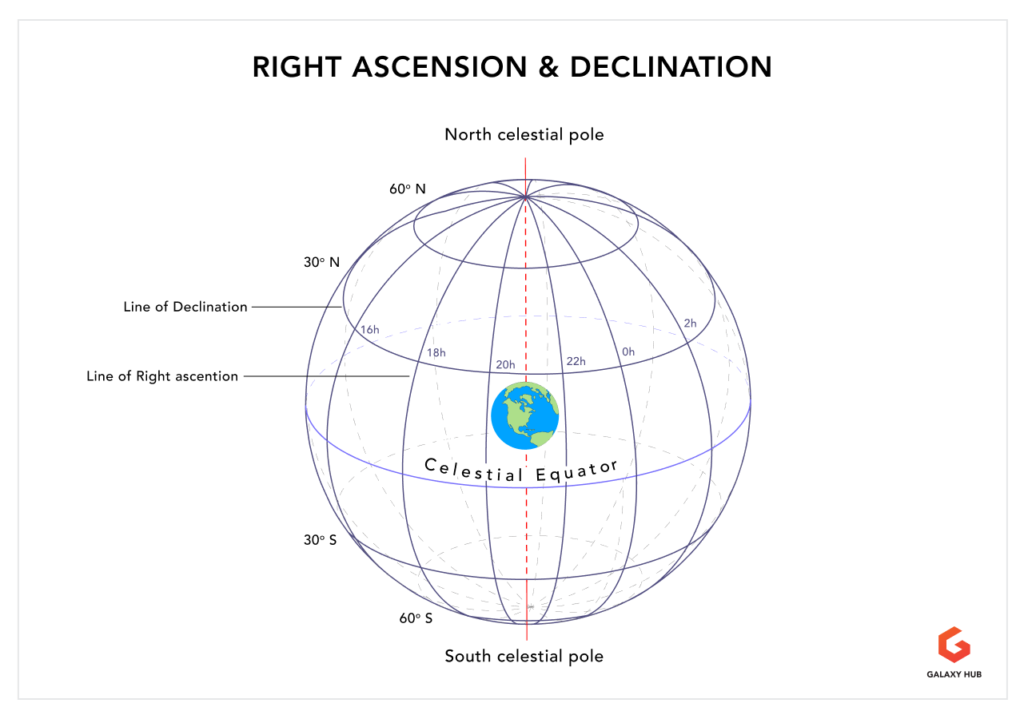In astronomy, we often use two methods to describe the positions of the Sun, Moon and planets. The first, Right Ascension (RA) and Declination, can be used to specify the position of any object in the sky, while the second, the ecliptic, is best suited to objects within the solar system. Beyond this, what’s the difference? And which system is best?
RA, Declination and the Celestial Equator
When it comes to describing the position of towns, cites and landmarks on Earth, we use latitude and longitude, with both being specified in degrees. It’s a similar story for objects in the night sky, but it works a little differently.
For starters, when it comes to the location of objects in the night sky, astronomers will often refer to the celestial sphere. This, essentially, is a starry globe that surrounds the Earth, so as we look up at the sky, we’re looking up at the inside surface of the globe. This celestial sphere, like the Earth, has a northern and a southern hemisphere, and an equator that divides the two.
However, instead of using latitude and longitude to specify the location of objects on the celestial sphere, we use Right Ascension (RA) and Declination, with declination being the equivalent of latitude and RA being the equivalent of longitude.
Earth-based locations in the northern hemisphere have a latitude that ranges from 0 to 90 degrees, or from 0 to -90 degrees if they’re in the southern hemisphere. Declination works in the same way for objects in the night sky.
If an object has a declination of zero degrees, then it lies on the celestial equator. If an object has a declination greater than zero (ie, from 0 to 90), then it’s said to be in the northern celestial hemisphere, but if an object has a declination of below zero (ie, from 0 to -90) then it’s said to be in the southern celestial hemisphere.
RA and declination can be used to describe the position of any object in the night sky, regardless of whether the object moves (such as the Sun, Moon and planets) or appears to remain stationary (such as the stars or deep sky objects, like stars clusters, nebulae and galaxies.)

Why is the celestial equator important?
Knowing the declination of an object is essential. Since declination on the celestial sphere is similar to latitude on Earth, there’s a direct correlation between the two, and knowing an object’s declination will give you an idea of whether it is visible from your latitude.
Any object in the northern celestial hemisphere (ie, with a declination greater than zero and therefore above the celestial equator) is visible from locations in the northern hemisphere on Earth. Similarly, any object in the southern celestial hemisphere (ie, with a declination of less than zero and therefore below the celestial equator) is visible from any location in the southern hemisphere on Earth.
Since objects on the celestial equator have a declination of zero degrees, they are theoretically visible from almost any latitude on Earth.
Given this, if you know your location’s latitude on Earth and the object’s declination on the celestial sphere, you can get an idea of whether that object is visible from your location.
Let’s say you live in the northern hemisphere and your target has a declination of -30 degrees. That object will be potentially visible from any latitude south of 60 degrees north (90 – 30 = 60.) On the flip side, if you live in the southern hemisphere and your target has a declination of 50 degrees, then it’s only visible from latitudes north of 40 degrees south (90 – 50 = 40.)
Besides determining an object’s declination, the celestial equator also plays a very important role in defining the start of the seasons (as explained further below.)
Want to get started in astronomy?
Our free telescope cheat sheet breaks down the key factors to choosing a telescope and shows you how to get stunning views of planets, nebula, and galaxies!

What is the Ecliptic Plane?
Put simply, the ecliptic plane is the circular path the Sun, Moon and planets appear to follow as they move across the sky.
The axis of the Earth is tilted by 23.5 degrees, and as a result, the ecliptic plane crosses the celestial equator at that angle. If both the Earth’s axis and the Earth’s orbit had no tilt, then neither would the ecliptic, and the Sun, Moon and planets would all appear to roughly follow the celestial equator in the sky.
According to astrology, the Sun, Moon and planets move through the twelve signs of the zodiac, but that’s not actually the case. In reality, the ecliptic also passes through the constellation Ophiuchus, the Serpent Bearer (between Scorpius and Sagittarius) and passes very close to several others.
Strictly speaking, the ecliptic is defined as being the path of the Sun as it moves across the sky, while the Moon and planets will often appear just to the north and south of the line.
That’s because the orbits of the Moon and planets are all tilted, so they’ll typically be offset by varying degrees. This causes them to occasionally appear in constellations outside the regular zodiac; for example, it’s possible for the Moon and planets to pass through the constellations Orion and Auriga, among others.
What is ecliptic latitude and longitude?
The number of degrees above or below the ecliptic plane is called the ecliptic latitude. For example, if the planet Jupiter had an ecliptic latitude of -1.5 degrees, then it appears 1.5 degrees to the south of the ecliptic in the sky. (From the northern hemisphere, it would appear to be below the ecliptic, whereas from the southern hemisphere it would appear above the ecliptic.)
Ecliptic longitude specifies how far along the ecliptic plane an object is. Like longitude on Earth, ecliptic longitude is measured in degrees, from zero to 360 (or as close to 360 as you can get; once it reaches 360 degrees, it resets back to zero.) For example, on March 1st 2023, Mars had an ecliptic longitude of 79 degrees – but 79 degrees from what?
Just as there’s a zero degrees longitude on Earth, so there’s also a zero degrees ecliptic longitude on the the celestial sphere. In this case, it’s called the zero point, and it’s the point where the Sun (following the path of the ecliptic) crosses from the southern celestial hemisphere into the northern celestial hemisphere. At that moment, the Sun lies on the celestial equator and has both a declination and an ecliptic longitude of 0.0 degrees.
Ecliptic longitude specifies how many degrees past that point the object lies. On a star chart, the Sun, Moon and planets appear to move in a counter-clockwise direction, from west to east, or from right to left. If the object has an ecliptic longitude of less than 180 degrees, then it is east of zero point. If, however, it has an ecliptic longitude greater than 180 degrees, then it is west of zero point.
How Does the Celestial Equator and the Ecliptic Longitude Define the Seasons?
Zero point, where the Sun crosses the celestial equator from the southern celestial hemisphere to the northern, is also important in another respect: this is the vernal equinox. In the northern hemisphere, this signifies the start of spring, while in the southern hemisphere it’s the start of autumn.
The opposite is true roughly six months later.
At that time, the Sun crosses the celestial equator from the northern celestial hemisphere to the southern. This the autumnal equinox (although, of course, in the southern hemisphere, it’s the start of spring.) At that time, the Sun has a declination of zero degrees and an ecliptic longitude of 180 degrees, as it is halfway along its circular path across the sky.
It’s a similar story when it comes to the solstices.
At the summer solstice in June, the Sun has a declination of 23.5 degrees north of the celestial equator, its most northerly point of the year. It’s also at an ecliptic longitude of 90 degrees, or a quarter of the way along its path. In the northern hemisphere, this signifies the start of summer, while in the southern hemisphere, it’s the start of winter.
Six months later, and the situation has reversed again. The Sun has a declination of 23.5 degrees south of the celestial equator, its most southerly point of the year. In terms of its ecliptic longitude, the Sun is now at 270 degrees, or three-quarters of the way along its path.
Want to get started in astronomy?
Our free telescope cheat sheet breaks down the key factors to choosing a telescope and shows you how to get stunning views of planets, nebula, and galaxies!

What’s the Best Way to Specify the Positions of the Sun, Moon and Planets?
As noted earlier, while RA and declination can be used to specify the location of any object in the night sky, it doesn’t make much sense to use the ecliptic longitude for any stationary object, as they don’t move and don’t follow the ecliptic plane. For that reason, RA and declination can be used for any object, whereas its typically best to use ecliptic longitude for the Sun, Moon and planets.
There are, as always, a few exceptions.
Specifically, the bright stars Regulus, Spica and Antares all lie close to the ecliptic, as do the star clusters M45 (the Pleiades) and M44 (the Beehive.) This makes it possible for the Moon and planets to frequently appear close to them, which casn often make for a very attractive sight through binoculars or a low-powered eyepiece. The Moon will also pass in front of (or, occult) these objects, while the planets can appear to pass among the stars of the star clusters.
Knowing the ecliptic longitude of those stars and star clusters, and being aware of the current positions of the Moon and planets, can therefore help to give you a heads-up on any upcoming celestial sights!







